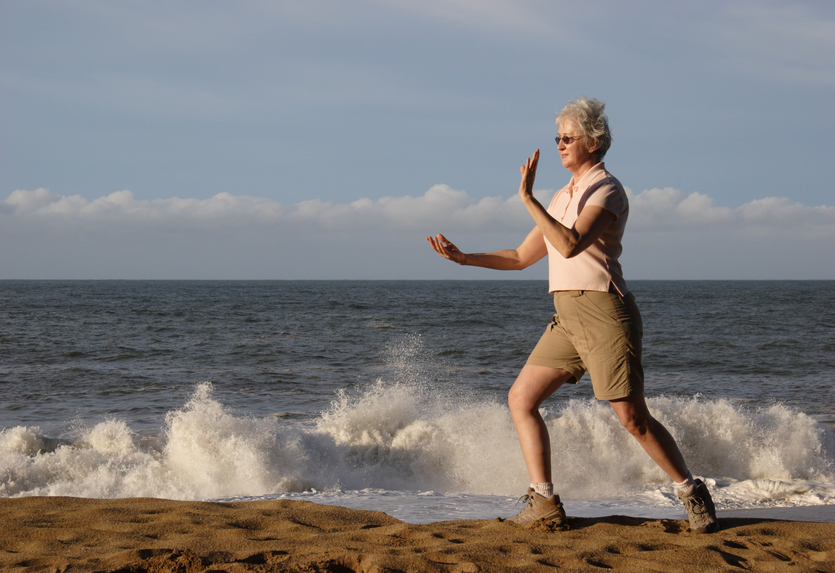
Tai chi, which originated in China as a martial art, is a mind-body practice in complementary and alternative medicine (CAM). It is sometimes referred to as “moving meditation”—practitioners move their bodies slowly, gently, and with awareness, while breathing deeply. The following is a general overview of tai chi and suggests sources for additional information.
Key Points
- Many people practice tai chi to improve their health and well-being.
- Scientific research is under way to learn more about how tai chi may work, its possible effects on health, and chronic diseases and conditions for which it may be helpful.
- Tell your health care providers about any complementary and alternative practices you use. Give them a full picture of what you do to manage your health. This will help ensure coordinated and safe care.
Overview
Tai chi developed in ancient China. It started as a martial art and a means of self-defense. Over time, people began to use it for health purposes as well.
Accounts of the history of the practice vary. A popular legend credits its origins to Chang San-Feng, a Taoist monk, who developed a set of 13 exercises that imitate the movements of animals. He also emphasized meditation and the concept of internal force (in contrast to the external force emphasized in other martial arts, such as kung fu and tae kwon do).
Tai chi incorporates the Chinese concepts of yin and yang (opposing forces within the body) and qi (a vital energy or life force). Practicing it is said to support a healthy balance of yin and yang, thereby aiding the flow of qi.
People practice by themselves or in groups. In the Chinese community, people commonly practice tai chi in nearby parks—often in early morning before going to work. There are many different styles, but all involve slow, relaxed, graceful movements, each flowing into the next. The body is in constant motion, and posture is important. The names of some of the movements evoke nature (e.g., “Embrace Tiger, Return to Mountain”). Individuals practicing must also concentrate, putting aside distracting thoughts; and they must breathe in a deep and relaxed, but focused manner.
Use in the United States
According to the 2007 National Health Interview Survey, which included a comprehensive survey of CAM use by Americans, an estimated 2.3 million U.S. adults had used tai chi in the past 12 months.
People practice for various health-related purposes, such as:
- For benefits associated with low-impact, weight-bearing, aerobic exercise
- To improve physical condition, muscle strength, coordination, and flexibility
- To improve balance and decrease the risk of falls, especially in elderly people
- To ease pain and stiffness—for example, from osteoarthritis
- To improve sleep
- For overall wellness.
The Status of Tai Chi Research
Scientific research on the health benefits of the practice is ongoing. Several studies have focused on the elderly, including tai chi’s potential for preventing falls and improving cardiovascular fitness and overall well-being. A 2007 NCCAM-funded study on the immune response to varicella-zoster virus (the virus that causes shingles) suggested that it may enhance the immune system and improve overall well-being in older adults. Tai chi has also been studied for improving functional capacity in breast cancer patients and quality of life in people with HIV infection. Studies have also looked at its possible benefits for a variety of other conditions, including cardiovascular disease, hypertension, and osteoarthritis. In 2008, a review of published research, also funded by NCCAM, found that tai chi reduced participants’ blood pressure in 22 (of 26) studies.
Side Effects and Risks
Tai chi is a relatively safe practice. However, there are some cautions:
- As with any exercise regimen, if you overdo practice, you may have sore muscles or sprains.
- Instructors often recommend that you do not practice tai chi right after a meal, or when you are very tired, or if you have an active infection.
- If you are pregnant, or if you have a hernia, joint problems, back pain, fractures, or severe osteoporosis, your health care provider may advise you to modify or avoid certain postures.
If You Are Thinking About Practicing Tai Chi
- Do not use tai chi as a replacement for conventional care or to postpone seeing a doctor about a medical problem.
- If you have a medical condition or have not exercised in a while, consult with your health care provider before starting.
- Keep in mind that learning tai chi from a video or book does not ensure that you are doing the movements correctly and safely.
- If you are considering an instructor, ask about the individual’s training and experience.
- Look for published research studies for the health condition you are interested in.
- Tell all your health care providers about any complementary and alternative practices you use. Give them a full picture of what you do to manage your health. This will help ensure coordinated and safe care.
Courtesy of the National Center for Complementary and Alternative Medicine



this is a vry valuable for a fitness of body , soul nd mind .
bcs this is helpful for health to control the mechanism of body fnxns .
so that is vry gud for health nd protect about disease complex !!!!
Thanks. Really happy you liked found it so useful.